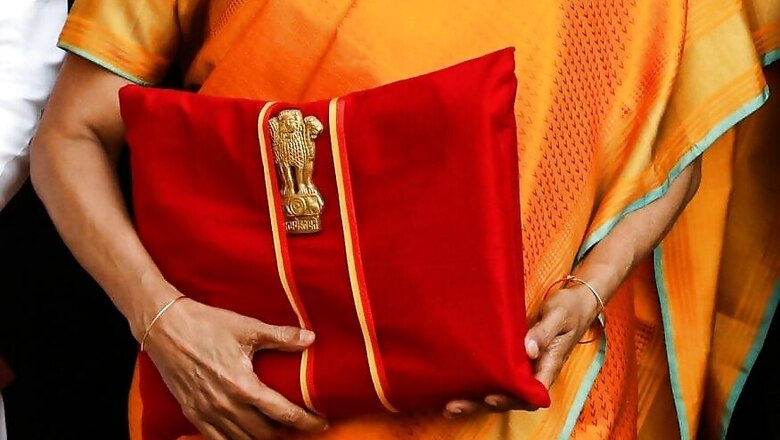
views
The Union Budget of 2021 must look beyond revenue and expenditure estimates for the next year. Instead, it should set the stage for unleashing economic growth for decades to come. In the short term, all four engines of economic growth – consumption, investments, government expenditure and exports – need to fire at full throttle.
In the long run, the Budget must ensure that the costs of making them run at full speed do not result in unsustainable levels of debt or systemic inequities. Therefore, the critical task before the Budget is to pick the right set of policy instruments to maximise economic growth at the least possible short-term and long-term costs. Boosting household consumption and reforming the ailing financial sector will be the key to achieving this goal.
Household consumption, representing more than half of the country’s GDP, contracted by 27% in the first quarter of 2020-21. Unemployment rates soared well over 20% during this period, and the informal sector was hit especially hard. While the recovery in the past two quarters is impressive, the rebound has been uneven across income segments.
Thanks to the unprecedented liquidity injection by central banks worldwide and soaring stock prices, the rich saw their fortunes rise. Their consumption is limited only by their concerns about the virus; money is not the issue. The Budget must make aggressive investments in vaccinating India, and soon the pent-up demand of the rich will translate into consumption.
The poor, on the other hand, have suffered permanent income shocks due to the pandemic. They have a high marginal propensity to consume but not enough resources to spend. The Budget should provide tax relief or direct financial assistance to the lower-income population to stimulate their consumption.
Investments by the private sector, another critical component of the GDP, will follow once consumers are back in the economy. However, it will be unreasonable to expect any spike in private investments anytime soon since uncertainty depresses investments. We still have a lot of uncertainty about new strains of the virus and the speed at which vaccines will get into people’s arms. Government expenditure, especially in infrastructure projects, can work its magic in the meantime. Infrastructure spending will also bring down the unemployment rate in the semi-skilled and unskilled labour market. Higher labour income should further boost the household consumption demand.
However, where will the government get the money to provide relief to the consumers and invest massively in infrastructure? The pandemic has put a severe strain on the government’s revenue collection this year. We may end up with a deficit of 7-8% in 2020-21, compared to the target of 3.5% for the year. The debt-to-GDP ratio for the government is already above 85%, making debt issuance an unattractive proposition from the perspective of long-run stability. And raising tax rates in the middle of the recovery will be counterproductive.
A reasonable approach to fund the additional expenditure will be to sell the government’s stake in underperforming public sector banks (PSBs) and other PSUs. With asset prices at an all-time high and the global market awash in liquidity, the timing of the sale could not be better. But it’s not only about the timing; India’s financial sector has been frail for a long time. Domestic credit to the private sector is around 50% in India, compared to the world average of 132%.
With the caveat that we cannot directly compare this number across economies without getting into country-specific nuances, China’s number stands at 160% and the US’s at 190%. India is well below global benchmarks in terms of credit availability, and it impedes economic growth.
The weak financial health of banks and NBFCs has been the primary cause of tepid economic growth even before the COVID-19 crisis hit us. Banks are yet to recover from the burdens of non-performing loans (NPLs) they built in the aftermath of the financial crisis of 2008-09, and the NBFC sector has been under tremendous stress after the IL&FS debacle.
The lack of credit has adversely affected the demand for automobiles, durable goods, housing, and several other items. This year’s Budget provides an excellent opportunity to rid India of its credit malaise by selling the government’s equity stake in the PSBs. Not only will it inject the much-needed private capital into our banking system, but it will also bring market-discipline and improvements in efficiency. However, in the long run, the privatisation efforts must be complemented with structural reforms in banks’ governance and restructuring of bad debt.
Besides, the Budget provides an opportunity for a reset of the Indian banking system. Instead of injecting more equity capital into underperforming banks, the government should start a new bank focused on funding large projects, perhaps exclusively infrastructure projects. The new bank can be funded initially with the government’s equity capital, which can be offloaded relatively soon to private markets. The new bank will eliminate the well-known “debt overhang” problem, i.e., the problem that banks become reluctant to make new loans when they have an enormous burden of existing bad loans.
This year’s Union Budget has a generational opportunity to propel India into a virtuous cycle of economic growth for years to come by targeting consumption growth and restructuring the financial sector.
Read all the Latest News, Breaking News and Coronavirus News here

















Comments
0 comment